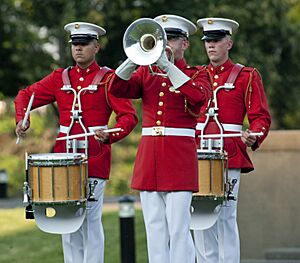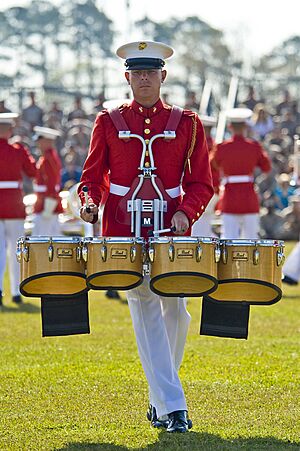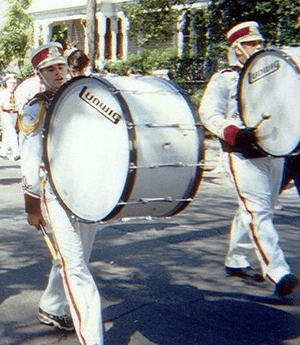Drum and bugle corps facts for kids
A drum and bugle corps is like a marching band, but it uses only brass instruments, percussion instruments, and a color guard. A color guard uses flags, rifles, and sabers to add visual effects to the performance. For hundreds of years, armies used drums and bugles to send signals. Modern drum and bugle corps grew from military drum and bugle groups after World War I and other wars. In the past, drum and bugle corps performed all year. Today, most corps go on tours during the summer. They travel across the country, performing a new show each year with different music and movements.
Contents
What is Drum Corps International?
How DCI Started
Before 1971, most American drum and bugle corps, often called "corps," performed in shows organized by the American Legion. In 1971, five important corps created a new group called the "Midwest Combine." Other corps in the east and west did similar things in their areas. These corps formed their own groups because they did not like the American Legion's rules. Many felt these rules stopped them from being creative. The corps also believed they did not get enough money from ticket sales.
The different groups decided to perform together in shows, one after another. This plan worked very well for them. In 1972, all these groups, plus a few others, formed a big organization called "Drum Corps International," or DCI. This group gave the corps more money from shows and more artistic freedom. The corps that perform in DCI also lead DCI. This means the competing members can change rules when needed. People who are not familiar with drum corps do not make these changes.
DCI Competition Classes
DCI has two main classes where corps can compete. The top class is called "World Class." In World Class, each corps can have up to 154 members. The corps leaders decide how these members are divided among the instruments and color guard. World Class corps also receive more money from DCI. They can vote on big decisions, like show times, rules, and how money is used. These corps spend a lot of time touring the country and visit many places.
The second class is "Open Class." In Open Class, a corps can have any number of members, from 1 to 154. These corps do not get as much money as World Class corps. They also have less say in big decisions. Open Class corps spend less time on tour. They usually stay closer to their headquarters. Sometimes, a corps can move from Open Class to World Class if they performed very well the year before. If a group wants to start a new corps, they always begin in Open Class.
DCI classes used to be different. There were once three classes called divisions: I, II, and III. There was also a "greater" Open Class, an "A" Class, and an "A60" Class (where corps could only have up to 60 marching members). There was even an All-Girls Class for corps made only of girls. Before 1983, most corps were all male.
Instruments in a Drum Corps
Brass Instruments
Before the year 2000, most drum corps played brass instruments with two buttons, or "valves." These instruments played a "G" note when no valves were pressed. These special instruments were called "bugles," which is where "drum and bugle corps" gets its name. Bugles are similar to other brass instruments. However, bugles were often not made very well, making them hard to play perfectly.
Today, most drum corps play instruments that sound a bit higher. They play a B-flat note when no buttons are pressed. These are called marching instruments. They sound and play very much like the instruments you hear in concert halls.
Drum corps perform outside on football fields. In a concert hall, sound bounces off walls and is directed to the audience. Outside, sound still bounces everywhere. But sound that isn't pointing straight forward can get lost. Because of this, marching instruments are shaped differently. Their big "bell" points towards the audience. This makes the sound as loud as possible for everyone watching. The four most common brass instruments in a corps are the trumpet, mellophone (like a French horn), baritone, and contrabass (like a tuba). For a long time, DCI rules only allowed these brass instruments. Now, DCI has changed the rules. More brass instruments are allowed, such as the trombone and euphonium. These other instruments are usually played by only one or two people in the corps. They often need microphones and speakers. Otherwise, the audience would not hear them over the many marching instruments on the field.
Drums
All drum corps use three main types of drums. These are the snare, tenors, and basses. Together with the cymbals, they form the "drumline."
The snare drum is the smallest of the three. It makes a short, loud, crunchy sound when hit. A corps can have between 6 to 10 people playing snare drums.
Tenor drums, or "tenors," are actually a set of 4 or 5 drums joined together. One person plays all of them. The different drums have different pitches. This allows players to create simple melodies. The tenor drum has a noticeable pitch and a sound like "oh." The sound can change depending on the type of stick used. A corps can have between 3 to 5 musicians playing tenor drums.
The bass drum is a very large drum. It is held sideways against the player's body. The musician uses two hands and sticks to hit both drum heads. It has the deepest sound of all the drums. It makes a low, round, closed sound when hit, with a less clear pitch. A corps usually has about 5 bass drums of different sizes. Five different people play them. Like the tenors, they can also play simple melodies.
Modern drum corps have marching drummers and also "front ensembles." These front ensembles play instruments that cannot be marched with. This includes timpani sets (kettle drums), vibraphones, marimbas, tubular bells, xylophones, and other "auxiliary" percussion. These would be too hard to carry while marching. Front ensembles can also have suspended cymbals, especially if the corps does not have marching cymbals.
Drumlines can also include cymbals. Cymbal players hold two identical metal cymbals in both hands. They slam them together to make a sustained crash sound. Many modern drum corps have stopped using cymbals in their drumlines. This is because cymbals can be expensive to keep up. A cymbal line also needs at least one extra staff member to teach them. This is because playing cymbals is very different from playing other drums. Also, a corps might have limited members. They might decide that a musician is more useful in the front ensemble, where they can play other instruments at the same time.





